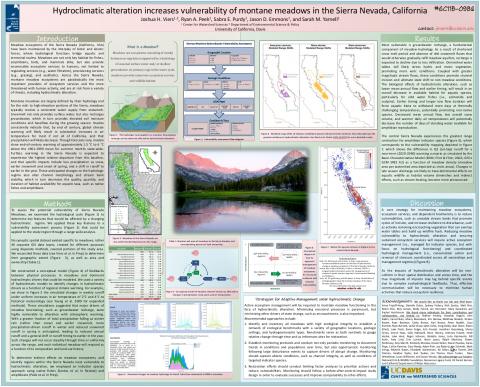Meadow ecosystems of the Sierra Nevada (California, USA) have been maintained by the interplay of biotic and abiotic forces, where hydrological functions bridge aquatic and terrestrial realms. Meadows are not only key habitat for fishes, amphibians, birds, and mammals alike, but also provide enumerable ecosystem services to humans, not limited to regulating services (e.g., water filtration), provisioning services (e.g., grazing), and aesthetics. Across the Sierra Nevada, montane meadow ecosystems are paradoxically the most important providers of ecosystem services and the most threatened with human activity, and are at risk from a variety of threats, including hydroclimatic alteration.
Montane meadows are largely defined by their hydrology and for the mid- to high-elevation portions of the Sierra, meadows typically receive a consistent water supply from snowmelt. Snowmelt not only provides surface water, but also recharges groundwater, which in turn provides elevated soil moisture conditions and baseflow during the growing season. Studies consistently indicate that, by end of century, global climate warming will likely result in substantial increases in air temperature for most if not all of California, and that precipitation will likely decrease. Though forecasts vary, models show end-of-century warming of approximately 1.5 °C to 6 °C above the 1961-1990 mean for summer months state-wide. Further, warming in the Sierra Nevada is expected to experience the highest relative departure from this baseline, and that specific impacts include less precipitation as snow, earlier snowmelt and onset of spring, and a shift in runoff to earlier in the year. These anticipated changes to the hydrologic regime also alter channel morphology and stream bank stability, which in turn decreases the quality, quantity, and duration of habitat availability for aquatic taxa, such as native fishes and amphibians.
